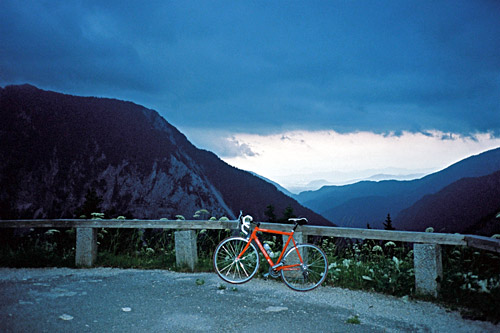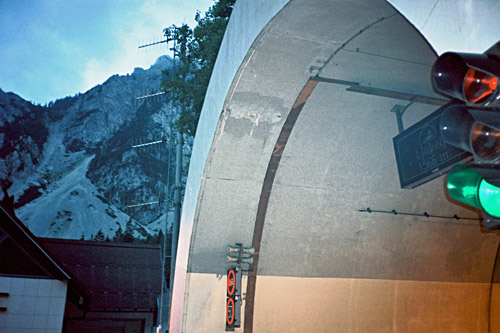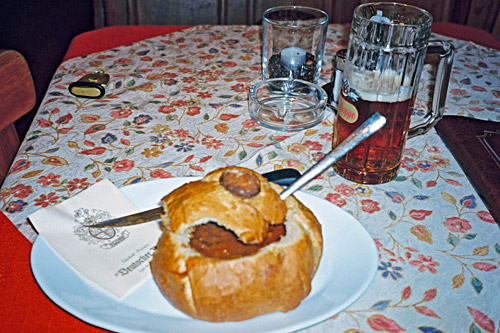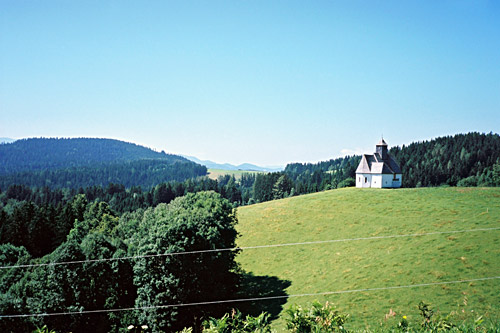
A wonderful morning. I woke up at this quiet and nice place in Soboth and went down for breakfast and got a full breakfast with boiled eggs. I asked about the road over St. Lorenzen (947m) (another St. Lorenzen from the one on the other side of Koglereck) and was told it was a nice alternative road down to Eibiswald (361m).
I argued a little with the lady of the house if Mauthnereck (923m) was not also a pass, which it really is, I explained, as there is a gravel road coming up from down in Slovenia (far below Soboth) to Mauthnereck. Also the Hadernigkogel (1184m) helps to define it. She did not think of it this way and it is of course not regularly used as a pass in this way. (One would also more likely use the way over Puschnigg (991m) and St. Lorenzen here, but Puschnigg also looks like a pass.) On the main road down to Eibiswald, one could conceivably also claim that St. Oswald (747m) is also a pass. It is an area of long ridges leading out from mountains, with smaller mountains formed along the way here and there, so it is easy to suggest possible passes in many places along those ridges. East of these mountains are no more mountains of any height in the Alps. But there are some more Eastern mountains northwards up to Vienna from here, which is an area I have still not explored.
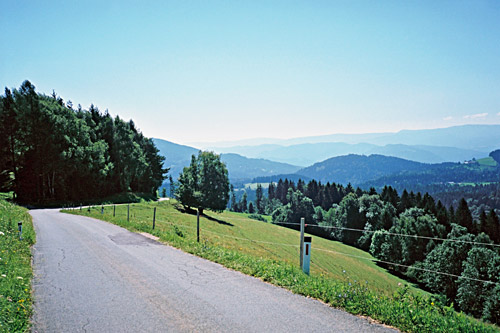
It was a lovely start of the day down on this road and it is very, very nice at St. Lorenzen, which is only metres away from Slovenia. I had hoped to take a track over to Radlpass (662m) (border pass), but found no obvious one (maybe saw the path down to the track). I asked some people coming walking up here and they tried to explain a short-cut asphalt road over there, which I had actually also studied in detail before and had tried to memorise, but even so I managed to miss it and then it was no fun to try and get back up. When coming down to Eibiswald it also felt a bit pointless to go up the normal pass road and back down again as the pass is rather low and I already saw it from above.
Now it was quite warm, but never complain about sunny weather when the alternative could be freezing in rain. I went directly up to Schwanberg (404m). It was a bit up and down to get there (like a normal Swedish road). Schwanberg is looking a bit nice. I stopped at a simple bar in the centre and had a coffee and ice cream. I asked which way up to Weinebene (1666m) would be hardest – from Schwanberg or from Deutschlandsberg a bit north. They were more or less the same we agreed on after a while. Apparently the road from Deutschlandsberg, which is the most well-known one, is a bit more consistently steep, while the one from Schwanberg, is very much off and on with some flattish stretches, but also some steeper stretches than on the other road. Apparently the little known road from Schwanberg had been used recently in Tour of Austria – if I understand it right, but maybe I was just thinking that they should have used this road and remember thinking that I would have had a hard time to come up with a harder road to compete up than this one. This road is guaranteed to make anyone tired with its irregularity and ”never-endingness” (esp. if continuing all the way up to Weinebene).
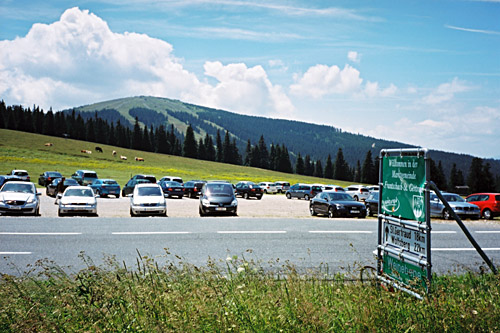
Weinebene (1666m) was the reason for my revisit to this area after having climbed the feared Grosse Speikkogel/Koralpenstrasse (2135m) in 2004, which I now circled around. (Speikkogel is similar to Passo dello Stelvio from Prato, only steeper all the way, but without the nice serpentines.) This was the lonely pass above 1600m in the whole area that I had to climb in order to complete my list of asphalted passes above this height. There are a number of passes only a bit under 1600m, so I fear I might have to return to the area if I should decide to continue to complete climbing the lower passes too. There are also many, many gravel pass roads in Austria above 1600m that could one day become asphalted and would likely have been asphalted if they had been located in any other part of the Alps. But gravel roads are popular in Austria and not so many people live up these mountains to justify the costs I guess.
23.5 km is the climb from Schwanberg (410m), while the climb is 22.5 km from Deutschlandsberg (368m), so more steep on average from Deutschlandsberg, but I very much doubt it is harder in real life. The climb from the west in St. Gertraud (503m) is considered as harder still, because of some steep kilometres early on and it might be. Roads always come across as being less steep when descending them, so cannot say for sure here. The road to Glashütten is quite steep at first, but then varies throughout and is a lovely road even if demanding.

There is a restaurant in Glashütten, but I continued out on the main road and the stretch from there to the top is quite boring actually. At the pass itself it is nice again with far-reaching views and nice views up the Koralpe. The road is actually descending slightly to the pass from the east and I believe the road height is maybe 1670m or more. The descent is very gentle for a long time, but suddenly the road climbs down from the ridge to a valley and here it becomes steep. I stopped at the little village of Frass (853m) for a wienerschnitzel at a very simple restaurant. Then there is still a bit steep descent left down to St. Gertraud (503m).
I continued down to Wolfsberg and tried to find a train there to get back a little westward again. It is quite boring down here, but there were no suitable train, so I decided to continue a bit in the same direction as the train to St. Andrä (433m), which is a terribly boring straight stretch through suburban shopping areas. St. Andrä is nicer though and I went to a café asking them about where the train station is and after they explained how to get there (which they almost did not knew as people here usually do not use the train these days), I stopped for a coffee and cake. I had ample of time before the train would leave, so I could have continued over the Griffner Berg (708m) as originally planned, but decided it would be as well to take the train for Klagenfurt as I just now had ruled out the idea of climbing Luschasattel (1295m) from Globasnitz (541m) as some accounts suggested that the road on this side was a bit bad gravel (although it is asphalt on the west side). And that idea also involved climbing Eisenkappeller hütte (1553m) from Bad Eisenkappel (556m) and it would simply take too much time for the little extra value it would provide, so I decided to skip them yet another time (also had thoughts last time when I was here to visit both places).
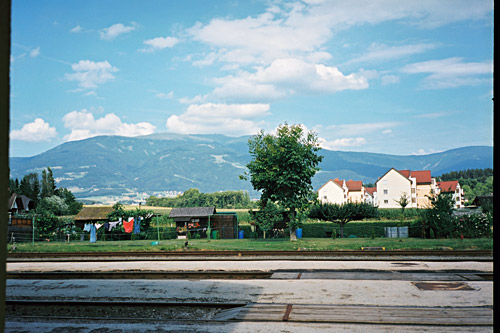
It took a long time before the train eventually arrived at the lonely St. Andrä station (I had a photo there up to Grosse Speikkogel). Then it was a slow and not so pleasant trip to Klagenfurt as there were some free-riding passengers the personnel wanted to get off the train but never managed to do (maybe a romanian or gypsy family/company) and there were much more other passengers including several mountain bicyclists joining the little train. Eventually we arrived in Klagenfurt and I went out and started to bicycle right away without looking at any map as I felt I knew more or less where to go. Klagenfurt is a rather flat city and somewhat easy to get out of south when arriving at the train station.
The big road south turned out to be a very busy road and it was also a very bad asphalt road. Actually this was the thing most surprising me this year in Austria – the terrible state that their roads are in. There are so very many bad roads in Austria and maybe it is the worst country in the Alps when it comes to road quality. There is a constant slow climb out of Klagenfurt (440m) on this bad road until just before (547m) the Ferlacher stausee, where one descends quickly to the other side at Kirschentheuer (436m). Here the road south to Slovenia starts climbing slowly up to Unterbergen (539m) and after a small descent the real hard climb up the Loiblpass starts and now most of the traffic is gone, thankfully.
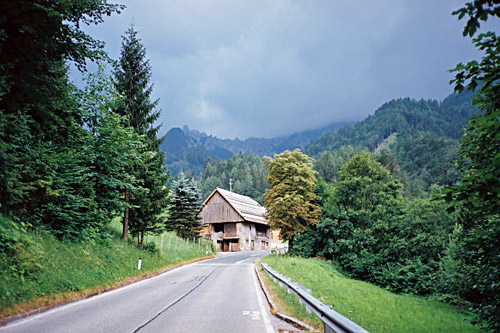
I do not know if I was out of shape, but it felt like a really hard climb up to Kleine Loiblpass (770m) and a local road biker passed me by without given me a chance to answer really (I was not in the mood and it was simply too steep for me then). It has just started to get back to nice temperatures from being really hot before. I was really impressed by this road, I must say and it felt like it was 18% ramps, but likely it was less. Then there is a significant descent to 682m. Now the climb start again almost as steep up to the real Loiblpass.
Here comes the really interesting thing of the day. The reason I had long been curious about this road was that I wanted to find out whether the old Loiblpass road was possible to ride up with a road bike and there has simply been no accounts anywhere that gave a hint about whether this was possible or not. Things could also have changed from earlier as so happens with gravel roads. I also noticed that there was asphalt on the top of the pass in some photo and probably dreamt a little about finding the road all asphalted. The road is a little legendary as it is known to be quite steep on both sides and therefore has frightened most cyclists away from even entering it into a plan. The Loiblpass tunnel that was built during the second world war with concentration camps inmates also terrifies because of its history.
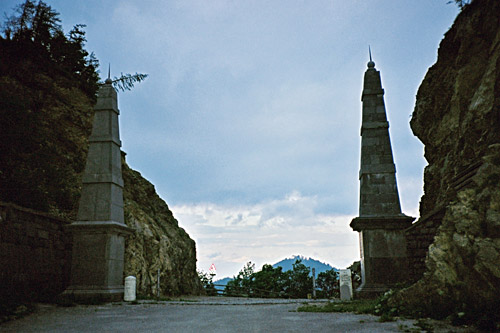
The weak nazis could not handle the old pass road, but surely that would not stop me or would it? I continued to climb and the weather had just started to look very ominous to the south just as I started the climb up to Kleiner Loiblpass. I must say that I was almost completely certain I would get rain this evening. Still I decided to climb up the jagged fence of peaks right up above me (you should have seen the view up there in this weather!). The road just get steeper and steeper. Just when I thought I had missed the turn-off for the gravel road to the old pass, I saw it all too clearly and it did not look good at all. Still I just went up there, but had to jump off and walk a little right away.
Should I continue? Yes, I will get up there no matter what, I decided. I jumped on the bicycle again, but after another bend it became a bit too much big stones in loose gravel, so I had to walk again for some hundred metres and then again I continued cycling, but could cycle most of the road up there with a clear risk for getting a flat. I had to walk again at possibly 2-3 more places, but kept jumping back on. The road was not as steep as I had heard. There was one short section early on with some asphalt, but otherwise I did not see any asphalt before the pass itself. Then came the last ramp up to the pass and here it was like 22%, I believe (and not 24% and more that I had heard). The ramp was so bad that I saw no possibility in making it on the bicycle, but decided that to climb this you have to try and if you fail, you fail. I failed and got a bit blood pouring down my elbow, but was happy I had tried and not chickened out.
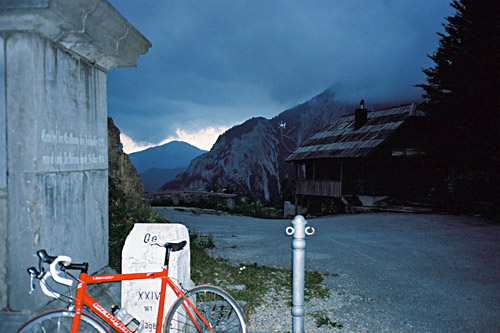
The pass itself is fantastic, with fine views in both directions, but mostly to Slovenia. Few road passes have such a sharp passage. It is like climbing a fence and get over it down on the other side. It was getting dark, but I reached the pass without rain, so I was very lucky. Then I just had to see the Slovenian side, which should be steeper (still). I had heard that it should be at least 28%. I tried to cycle down parts of it but was close to falling a couple of times, so had to resort to walking most of the way down. Both sides of the pass are just a little too bad for a road bike. If only they could have asphalted this, then it would have been a really popular place even for road bicyclists wanting a challenge.
The south side was perhaps max 24% I would estimate. Usually I can ride up to ca. 20% slopes on gravel (if good), but this was a bit too much and too bad. Some parts were better. Lastly, as I had heard, the road was completely barricaded on the Slovenian side and it took me a while to realise that I would do best to climb down a well used path going off just before the end. I got down and now it was almost dark. Through the tunnel and full speed down the steep road in order to get as far as possible before it would be impossible to see the road without a front light. I managed to just get down to Gasthof Deutscher Peter near the bottom before the climb up to Kleine Loiblpass and went in there to get a room and had one. I got a simple dinner (photo) with gulasch in a bread (never seen this before). It looked nice and worked fine with the nice beer they had. A decent place to stop at.
